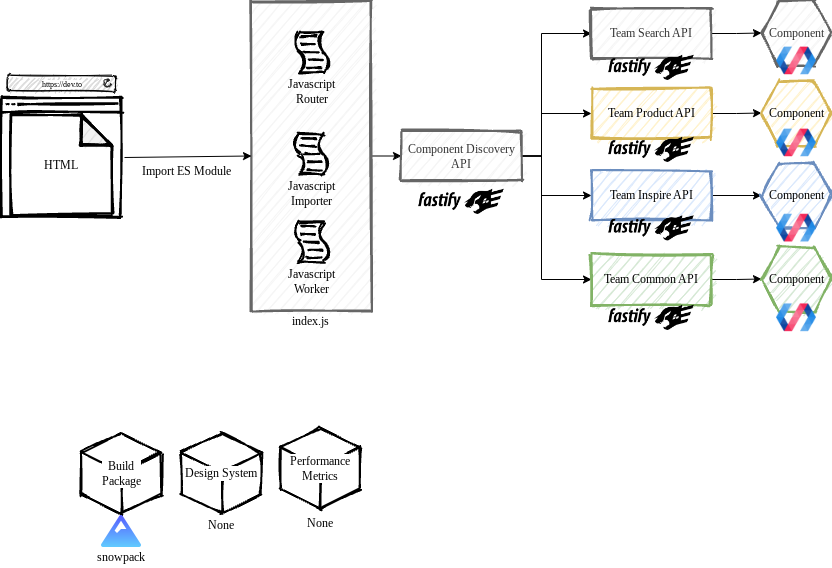Micro Frontends on the Client Side (ES Module)
Happy New Year 2021. I look forward to your continued support this year. Recently, I've been working hard on aerobic exercise because I've gained weight.
In this article, I would like to talk about Micro Frontends with client-side integration, which I have been testing since last winter. The source code I tested is in the following repository.
https://github.com/silverbirder/micro-frontends-sample-code-6
Overview
The overall design image is as follows.

The server side only returns static content, and the application is built on the client side.
The construction method uses ES Module Import, which is a browser standard, and loads the Javascript (index.js, for bootstrap) necessary for the application.
The components of each team necessary for the UI are obtained via the API and rendered.
Javascript Module
I was thinking of including the following modules in Javascript (index.js).
- DOM Parser
- Get information of any element
- Importer
- Get any module
- Router
- Manage the routing of the entire web application
- Worker
- Manage processes to be executed in the background
- EventHub
- Control communication between modules
I was roughly thinking about these, but in the end, I only implemented Importer and Router (laughs). I ran out of energy.
Also, as a premise, I try to make each team's dependencies as independent as possible. In Micro Frontends, the benefits can be enjoyed only when they are independent, so I try to avoid commonalization of each team as much as possible.
Javascript Importer
As written in the overall design image, the Javascript Importer imports each team's component through the Component Discovery API. This configuration is similar to the Service Discovery Patterns of Microservices. By adopting this configuration, each team can be independent (non-dependent).
Javascript Router
The Router manages the entire application's routing. For example, / is the top page, and /s is the search page.
We used vaadin/router for the Router, which is compatible with WebComponents, which we will explain later.
In vaadin/router, we specify WebComponents for routing, and the specified WebComponents are obtained from the Importer.
Component
Components use a library based on WebComponents called LitElement. If each team imports their Component (including the LitElement library), it will result in duplicate loads and poor performance. We recommend pre-loading common libraries (with import maps, etc.).
Since it's WebComponents, it will be rendered in the Shadow DOM. The scope of CSS can be independent, so it won't affect others. However, if there is a Design System, such as wanting to unify the overall brand color, you need to (carefully) consider how to standardize the Component.
Build Package, Design System, Performance Metrics
Even if each team wants to be independent, I believe there are things that need to be standardized. What I'm assuming is as follows:
- Design System
- Unify the design of all components
- Performance Metrics
- Unify the rules of measurement indicators throughout
- Rendering Time
- Response Time
- etc
- Unify the rules of measurement indicators throughout
- Build Package
- Unify how to handle libraries
- External
- ECM Version
- etc
- Unify how to handle libraries
I'm just writing this, but I haven't actually tried it (laughs).
Impressions
As with server-side integration of Micro Frontends, a service that aggregates and provides Components was necessary for client-side integration. In this case, it's the Component Discovery API. This is a layer to reduce the dependency between Components, and I think it's almost essential in Micro Frontends.
Finally
Micro Frontends are important for integration patterns, but what's more important is how to decompose the domain. If this division is not appropriate, a case that must be standardized will inevitably be born, and I think the benefits of Micro Frontends cannot be utilized. I want to verify it at the production level soon, but I'm still reluctant to get started.
Share
Related tags
- I read 'Micro Frontends'
- Defining Fragments Composed in Micro Frontends as Web Components and Sharing them with Module Federation
- Memo Micro Frontends
- Building Micro Frontends with Cloudflare Workers (Edge Worker)
- Everything you need to know about Micro Frontends
- Micro Frontends with Zalando tailor (LitElement & etcetera)
- Micro Frontends with SSR in Ara-Framework
- Everything I Learned About Micro Frontends
- Created an App to Consistently Record and Visualize Data in a Free Format
- Developing "Bochi-Bochi", an App to Easily Find Cheap Ingredients
- What I Learned from Refreshing My Blog Page with Qwik
- Introducing AI Ghostwriter - A Tool to Improve Writing Efficiency
- Development of Stable Diffusion API
- Defining Fragments Composed in Micro Frontends as Web Components and Sharing them with Module Federation
- Created OEmbed and OGP WebComponents for use on my blog site
- Things I Learned from Developing Chrome Extensions (Manifest V3)
- If you're writing in Markdown, Rocket, an SSG that uses WebComponents, is recommended!
- Refreshing Silverbirder's Portfolio Page (v2)
- I Made an API That Only Returns Google Account Images
- Building a TikTok Scraping Infrastructure on GCP and the Challenges Faced
- Micro Frontends with Zalando tailor (LitElement & etcetera)
- Micro Frontends with SSR in Ara-Framework
- Created a GAS Library, zoom-meeting-creator, to Automatically Generate Zoom Meetings
- Introducing a Tool for Bulk Updating Account Images and What I Learned
- Cotlin is a Tool for Collecting Links on Twitter, Discover Presentations from Around the World
- I tried creating rMinc, a service that registers GMail to GCalendar
- I Tried Making a One-Frame Comic Search Service Tiqav2 (Algolia + Cloudinary + Google Cloud Vision API)
